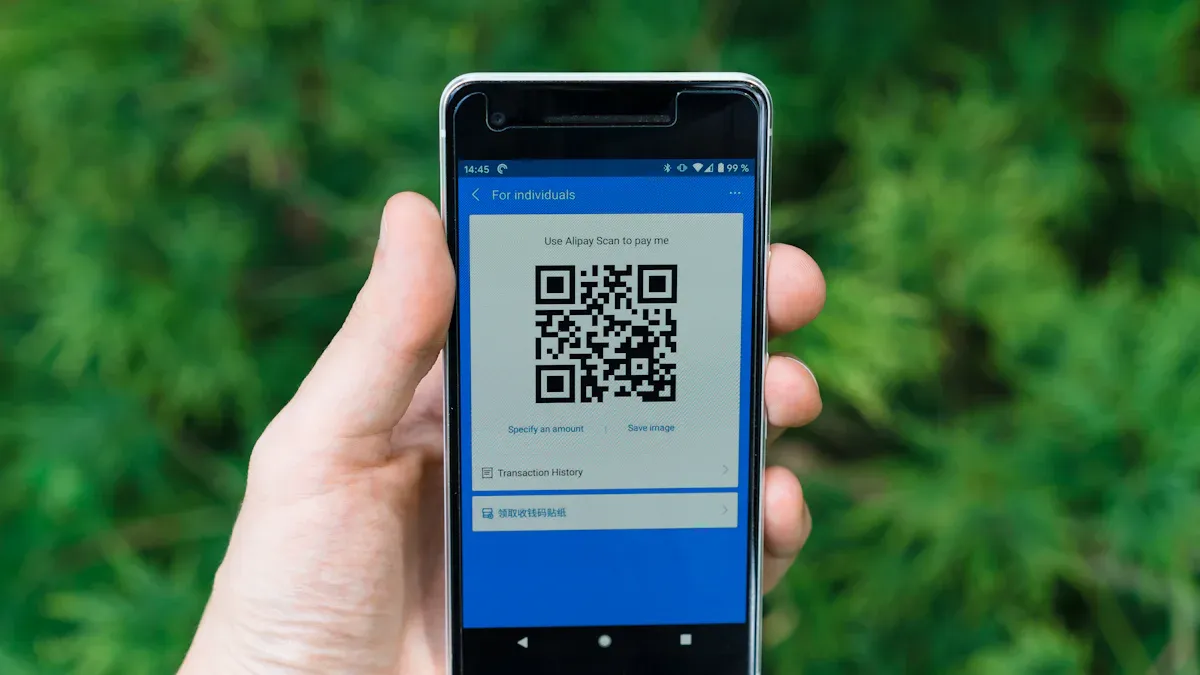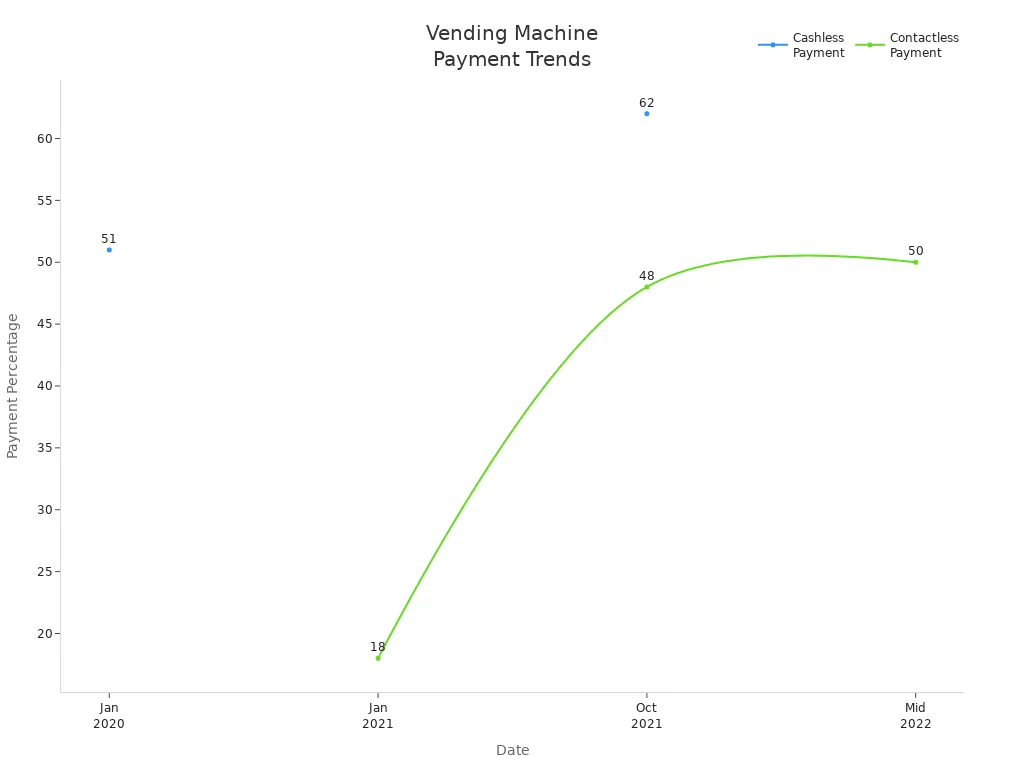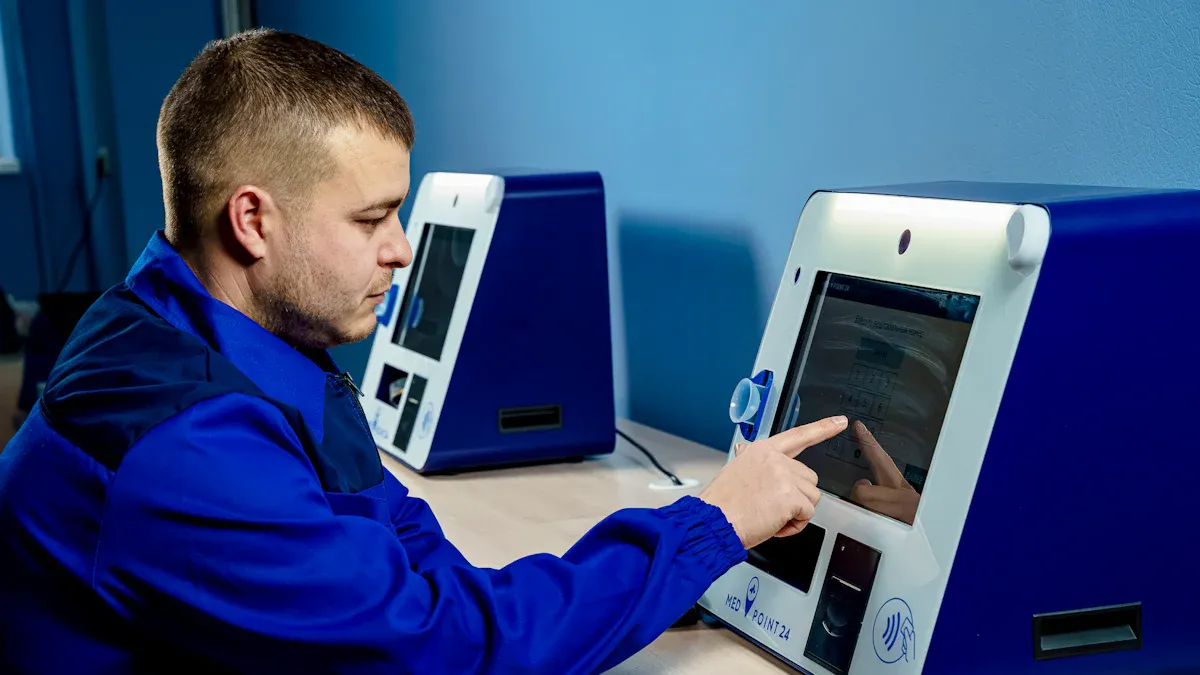QR Code Integration in Modern Vending Machines: Benefits and Implementation

A modern vending machine often stands out for its seamless customer experience, driven by qr code integration. In 2024, over 65% of vending machines worldwide support contactless payments, and nearly half of US units offer smart payment options like QR code scanning. This shift toward cashless convenience meets customer demand for speed, hygiene, and flexibility. Machine operators see increased revenue and efficiency, while customers enjoy a frictionless experience at every machine. Integration of qr codes now defines the standard for vending, transforming both customer interaction and operational success.
Key Takeaways
QR code integration makes vending machines faster, safer, and more convenient by enabling contactless payments and personalized customer experiences.
Operators gain real-time inventory tracking and remote maintenance tools, which reduce downtime and increase profits.
Data collected from QR code transactions helps operators understand customer preferences and optimize product offerings.
Offering multiple cashless payment options, including QR codes, meets diverse customer needs and boosts satisfaction.
Educating customers with clear instructions and secure payment systems encourages adoption and builds trust.
QR Code Integration Benefits
Customer Engagement
Smart vending software powered by qr code integration transforms the way customers interact with snack vending machines. Customers now expect convenience and personalization at every step. QR code systems support contactless, touchless transactions, which improve both convenience and safety. These systems allow customers to scan and pay quickly, reducing wait times and making the overall experience smoother.
QR code systems enable real-time interaction and feedback collection, which strengthens customer relationships.
Loyalty programs and incentives, such as discounts and rewards, encourage repeat purchases.
Personalized incentives based on purchase tracking increase customer retention and engagement.
Feedback loops through QR code interfaces let customers rate their experience and suggest improvements, fostering loyalty.
A study of over 2,000 digital signage campaigns found a 300% increase in interaction rates when qr codes were used effectively. This boost came from strategic placement, value-driven messaging, and easy-to-scan designs. These principles apply directly to snack vending machine sales, where qr code integration creates a seamless and rewarding customer experience.
Gamification techniques, such as scanning streaks, milestone rewards, and in-app challenges, add excitement to the vending process. Exclusive qr code offers, including VIP access and flash sales, provide personalized experiences that drive higher participation and repeat visits. Smart vending software uses these features to build strong customer loyalty and increase vending machine sales.
Tip: Operators can use qr code systems to launch limited-time promotions, encouraging customers to return to the same snack vending machine for new deals.
Operational Efficiency
Operators see major improvements in operational efficiency with qr code integration. Smart vending software simplifies cashless payments, allowing customers to pay with a quick phone scan. This reduces the need for cash handling and speeds up transactions, which increases overall machine throughput.
Real-time stock monitoring and replenishment alerts help reduce downtime.
Remote troubleshooting capabilities improve machine uptime.
Integration with cashless payment systems streamlines transactions.
Data collection via qr codes enables analytics for inventory and marketing optimization.
Smart vending software collects data from every transaction, helping operators adjust inventory and optimize product placement. Real-time inventory monitoring ensures that popular items remain stocked, while replenishment alerts prevent out-of-stock situations. These features reduce maintenance needs and keep snack vending machines running smoothly, which boosts vending machine profits.
Remote troubleshooting allows operators to address issues without visiting each machine. This saves time and resources, further increasing operational efficiency. By using qr code systems, operators can focus on high-traffic locations and maximize vending machine sales.
Data and Analytics
QR code integration unlocks powerful data and analytics capabilities for vending operators. Smart vending software tracks every scan, purchase, and interaction, providing deep insights into customer behavior and inventory trends.
Real-time inventory monitoring and demand prediction optimize stock levels and reduce waste.
Consumer behavior insights come from transaction data and product selection trends by location.
Transaction details include payment methods and loyalty program usage.
Customer interaction data covers product browsing and engagement with promotions.
Functional data from qr code features, such as item reservation and pickup tracking, adds another layer of insight.
Operators use this data to identify popular products and high-traffic snack vending machine locations. QR code analytics reveal user demographics and device information, enabling tailored marketing campaigns. Tracking campaign performance through qr code scans helps operators refine their strategies and improve vending machine sales.
Smart vending software integrates with tools like Google Analytics, enriching data on user behavior. This continuous optimization leads to better product offerings, more effective promotions, and increased vending machine profits. QR code systems also allow customers to reserve items for pickup, adding convenience and expanding data collection opportunities.
Note: Data-driven decisions help operators reduce waste, improve customer experience, and maximize vending machine sales.
Contactless and Cashless Payments

Payment Flexibility
Modern vending machines now offer unmatched flexibility in payments. Customers can choose from a wide range of options, including QR code payments, credit and debit cards, mobile wallets, and NFC-enabled devices. This multi-payment approach ensures that every user finds a convenient way to complete vending transactions. QR code payments stand out because they require no extra hardware and work with any smartphone. These payments integrate seamlessly with other cashless solutions, making them popular in locations with international visitors or tech-savvy users.
Metric | Percentage/Value |
|---|---|
Vending machines offering cashless payments | |
Vending transactions that are cash-free | 72% |
Year-on-year increase in cashless machines | 20% increase |
Store shoppers using contactless cards | 58% |
A majority of vending transactions now use cashless payments, with 72% of all transactions being cash-free as of January 2024. This trend shows a strong preference for digital payment technologies in vending environments. The chart below highlights the rapid growth of cashless and contactless payments in vending from 2020 to 2022.

QR code payments also speed up vending transactions. Business studies show that these payments reduce wait times and checkout steps, leading to higher customer satisfaction. Retailers and vending operators report increased sales and faster service after adopting QR code payments. Customers appreciate the ability to pay quickly and avoid handling cash or searching for exact change. The combination of QR code, card, and mobile wallet payments creates a smooth, cashless experience for every vending machine user.
Tip: Educating customers about available payment options at the point of sale increases adoption and satisfaction.
Hygiene and Safety
Hygiene and safety have become top priorities for vending machine users. Contactless payments, especially QR code payments, help reduce physical contact with shared surfaces. Customers can complete cashless transactions by scanning a code on the machine, avoiding the need to touch buttons, cash, or card readers. This touchless approach minimizes the risk of spreading germs, which is especially important in high-traffic areas like schools, hospitals, and offices.
QR code payments enable 100% touchless transactions, supporting social distancing.
Touchless payments reduce handling of coins and bills, which often carry germs.
App-based payments allow remote browsing and product selection, further limiting contact.
Smart vending systems send maintenance and stock alerts, keeping machines cleaner and safer.
Public health concerns, especially during the COVID-19 pandemic, accelerated the adoption of cashless technology in vending. Consumers now recognize the health benefits of contactless payments, such as reduced physical contact and enhanced safety. The widespread use of QR codes for health verification has also increased trust in QR code payments. As a result, vending operators see higher usage of cashless transactions and improved customer confidence in machine hygiene.
Note: Vending machines with intuitive, easy-to-clean interfaces further reduce health risks and boost user confidence in shared spaces.
Vending Operations Optimization
Real-Time Inventory
Smart vending software transforms how operators manage inventory in every machine. Operators use IoT technology and integrated sensors to monitor stock levels in real time. Each time a customer completes a transaction using a QR code, the system links the purchase directly to inventory updates. This process ensures that stock changes appear instantly in a cloud-based management system. Operators receive automated restock alerts, which help prevent shortages and keep every vending machine ready for customers.
Smart vending software uses sensors and QR code data to track inventory changes.
Operators receive real-time notifications for low stock or expiring products.
QR codes store detailed product information, streamlining inventory checks.
Smartphone scanning allows quick updates without special equipment.
Enhanced security features protect inventory data and restrict access.
The table below shows how QR code integration improves each stage of the inventory process for vending operators:
Inventory Process Stage | QR Code Functionality | Reported Benefits for Vending Operators |
|---|---|---|
Receiving & Stocking | Automatic inventory updates with product details | Faster check-in, fewer manual errors |
Storage & Organization | Real-time tracking across locations | Better visibility, less misplacement |
Tracking Usage & Consumption | Real-time stock level updates on scanning | Prevents stockouts, improves accuracy |
Reordering & Restocking | Auto-restock alerts when stock is low | Faster restocking, prevents shortages |
Compliance & Expiry Management | Flags soon-to-expire or recalled items | Ensures safety, reduces waste |
Asset & Equipment Management | Real-time location and maintenance history | Better asset use, fewer lost assets |
Smart vending software also integrates with cloud systems, making data synchronization seamless. Operators can scale their inventory management as their vending business grows. QR codes validate who manages inventory, increasing accountability and traceability.
Tip: Operators who use real-time inventory tracking reduce waste and improve profits for every snack vending machine.
Maintenance Reduction
QR code systems help operators reduce maintenance issues in every machine. Smart vending software enables fast inspections and accurate data logging. Operators can schedule preventive maintenance more efficiently, which lowers the risk of machine malfunctions and downtime. QR codes minimize problems with cash and coin mechanisms by supporting cashless operations. This shift speeds up work order resolution and reduces manual tasks.
QR code-enabled workflows help manage technical glitches and software updates.
Operators report fewer equipment failures and less downtime.
Centralized asset management makes it easy to track machine maintenance history.
Quick issue reporting through QR codes leads to faster repairs.
Smart vending software supports cashless operations, which means fewer moving parts in each machine. Operators spend less time fixing cash-related problems and more time optimizing vending performance. QR code systems also improve maintenance efficiency by allowing authorized personnel to access machine data instantly.
Note: Operators who use QR code systems for maintenance see longer machine lifespans and higher customer satisfaction.
Implementation Steps

Needs Assessment
Operators should begin by evaluating their current vending machine fleet and business objectives. They must identify which machines require upgrades and determine the types of payments their customers prefer. Operators should analyze customer demographics, machine locations, and transaction volumes. This assessment helps prioritize which machines will benefit most from digital payment integration. Operators also need to consider the technical capabilities of their existing hardware and software. By understanding these factors, they can set clear goals for QR code integration and ensure a smooth transition.
Tip: Operators who involve stakeholders early in the process gain valuable insights and avoid costly mistakes.
Platform Selection
Selecting the right QR code platform is critical for successful vending integration. Operators should follow these criteria:
Confirm the platform supports GS1 barcode syntax, including GS1 Digital Link URI, for compliance and multifunctionality.
Ensure the platform generates barcodes quickly and at high quality, suitable for vending machine environments.
Check compatibility with current scanning hardware and back-office systems.
Verify compliance with industry standards, such as GS1 General Specifications.
Collaborate with partners, solution providers, and GS1 organizations to ensure interoperability.
Choose an encoding strategy that keeps data compact and efficient.
Select an error correction level that balances durability and barcode size for vending machine use.
Use GS1 Digital Link URI to provide rich product information and enhance consumer engagement.
Make sure the platform offers barcode verification for reliable scanning.
Operators who follow these steps ensure their QR code integration meets both current and future needs. They also position their vending business for long-term success.
Payment Integration
Integrating QR code payments with vending machines requires careful planning. Operators should focus on these best practices:
Use QR codes to enable contactless payments, improving hygiene and convenience.
Offer flexible payment options, including e-wallets and mobile banking apps.
Choose payment systems that support fast and secure transactions.
Reduce maintenance costs by minimizing cash handling and mechanical issues.
Provide digital receipts through QR codes to support sustainability.
Ensure stable internet connectivity for reliable transaction processing.
Use high-quality QR code generators to avoid scanning problems.
Combine QR code payments with other options, such as cards and mobile wallets, to maximize customer satisfaction.
David Riddiford, president of Apriva, recommends that payment solutions support multiple cashless methods, including QR code scans, cards, and biometrics. He stresses the importance of tailored solutions that fit each vending operator’s unique needs. Operators who follow these guidelines achieve seamless digital payment integration and improve the customer experience.
Security Measures
Protecting customer data during QR code transactions is essential. Operators should use advanced security measures to safeguard privacy. Blockchain technology helps avoid centralized data storage, increasing security and privacy. Customers can create digital identities stored on their mobile devices, so personal data never resides on the vending machine or third-party servers. During transactions, only proof of eligibility, such as age verification, is transmitted. Biometric verification, like 3-D face mapping, ensures authenticity and prevents fraud. These measures reduce liability and protect customer data throughout the payment process.
Note: Operators who prioritize security build trust and encourage more customers to use digital payments.
Customer Education
Educating customers about QR code payments increases adoption and satisfaction. Operators can use several strategies to make the process easy and engaging:
Strategy Purpose | Description | Example / Help Note Text |
|---|---|---|
Use QR codes linking directly to app download pages to reduce effort and increase scans. | 'Scan to download app' | |
Provide quick tutorials | Link QR codes to webpages or videos explaining how to use the vending machine, overcoming language barriers via online translation. | 'Scan for assistance' |
Collect customer feedback | Link QR codes to feedback forms to simplify the process and encourage more responses. | 'Scan to give feedback' |
Provide quick contact info | Link QR codes to contact details (phone/email) to eliminate manual typing and speed up customer support. | 'Scan to save contact' |
Conduct quick surveys | Link QR codes to survey forms to reduce paper use and simplify data collection. | 'Scan to fill survey' |
Operators should display clear instructions on each machine. They can use simple language and visual cues to guide users through the payment process. Tutorials and feedback forms linked to QR codes help customers learn quickly and share their experiences. These efforts make digital payment integration more accessible and enjoyable for everyone.
Tip: Operators who offer easy-to-understand instructions and support see higher adoption rates for QR code payments.
Case Studies
Success Stories
Many operators have transformed their vending businesses by using QR code technology. Across different industries, QR codes help collect real-time feedback and improve customer satisfaction. Operators in corporate offices use QR code feedback to learn what snacks employees want. When customers asked for healthier options, operators replaced sugary snacks with protein bars and trail mixes. This change led to higher sales and happier customers.
Fitness centers and wellness locations also use QR codes to adjust product offerings. Customers scan codes to rate products or suggest new items. Operators then use this data to stock snacks that match customer preferences. Community centers benefit from QR code systems by creating a feedback loop. Customers can report issues or request products, and operators respond quickly. These systems use advanced analytics to optimize inventory and reduce waste. QR code integration, combined with mobile apps and AI, turns vending machines into smart retail solutions.
Operators who listen to customer feedback see better sales and stronger loyalty.
Lessons Learned
Operators have faced challenges when adding QR code systems to vending machines. Some customers find QR code payments difficult, especially those less familiar with technology. In regions without a common payment standard, operators must use different QR codes for each provider. This can confuse customers and slow adoption.
Operators learned several key lessons:
Keep the vending interface simple. Too many ads or upsell messages make it hard for customers to complete purchases.
Provide clear feedback during transactions. Customers trust the system more when they see updates and confirmations.
Place input and output devices close together. This design helps customers understand how to use the machine.
Address security concerns. Customers want to know their payments are safe and transparent.
Offer support options. Without human help, customers can get frustrated if something goes wrong.
Note: Operators who focus on user experience and clear communication improve adoption and increase vending sales.
Future of QR Code Integration
Trends in Vending
Vending continues to evolve as operators adopt new technology and respond to changing customer needs. Over the next five years, several trends will shape the future of vending and cashless payments:
Operators will rely more on cashless payment methods, including QR codes and digital wallets, because they offer speed and user-friendliness.
Real-time data analytics will help operators monitor inventory, track sales, and spot product trends. This technology will make vending more efficient and profitable.
The unattended payments industry is expected to reach $129 billion globally by 2030. This growth shows strong demand for cashless solutions in vending.
Contactless payments, such as QR codes and NFC, will become the main way people pay at vending machines. These methods reduce downtime and speed up transactions.
Artificial intelligence will allow vending machines to suggest products based on what customers bought before. This personalization will improve the customer experience.
IoT and AI will help operators manage inventory and sales in real time, reducing waste and boosting profits.
Remote management solutions will let operators monitor machines, analyze data, and fix problems from anywhere, improving uptime and lowering costs.
Hybrid retail models will combine vending machines with shelves or lockers, creating new shopping experiences.
Customization and personalization will let operators adjust vending machines for different brands and products.
These trends show that cashless technology will remain at the center of vending. Operators who invest in smart vending solutions will stay ahead in a fast-changing market.
Sustainability
Sustainability is becoming a key focus in the vending industry. QR code integration supports eco-friendly practices in several ways. Cashless payment systems reduce the need for physical cash and paper receipts, which helps cut down on waste. Operators also use technology to improve efficiency, saving resources and energy.
Reverse vending machines now use QR codes to reward users for recycling bottles and cans. Customers scan a code to claim rewards, join promotions, or learn about their environmental impact. Loyalty programs encourage people to recycle more by giving points for each return. Digital signage on these machines shows real-time statistics about recycling, helping educate users and promote sustainable habits.
QR code scanning also makes it easy for customers to download apps that track recycling and manage loyalty points. This digital engagement supports refill culture and reduces single-use plastics. Businesses benefit by building stronger customer relationships and meeting corporate social responsibility goals.
Solar-powered vending machines and recyclable packaging are also on the rise. These solutions often work with cashless payment systems, including QR codes, to create a seamless and sustainable experience. As more customers expect eco-friendly options, operators who use technology to support sustainability will lead the vending industry into the future.
Vending operators see clear benefits from QR code integration. They can design engaging campaigns, connect QR codes with payment systems, and use data to personalize the customer experience. Operators also improve inventory control and speed up maintenance. To move forward, they should review current vending operations or consult technology providers. Staying updated with cashless trends helps operators deliver greater consumer convenience and enhance every customer interaction. Operators who explore QR code solutions position their vending business for growth and innovation.
FAQ
How do customers use QR codes on vending machines?
Customers scan the QR code displayed on the vending machine using their smartphone camera or a payment app. The code links directly to a secure payment page or app, allowing quick and contactless transactions.
Are QR code payments secure for vending machines?
QR code payments use encrypted data and secure authentication. Operators often use advanced security measures, such as tokenization and blockchain, to protect customer information and prevent fraud.
What types of payments can QR codes support?
QR codes support various payment methods, including mobile wallets, credit cards, and bank apps. This flexibility allows customers to choose their preferred payment option, improving convenience and satisfaction.
Can operators track inventory using QR codes?
Operators can track inventory in real time. Each QR code transaction updates stock levels automatically. This system helps prevent shortages and ensures machines stay fully stocked.
Do QR codes work with all vending machines?
Most modern vending machines support QR code integration. Older machines may require hardware upgrades or software updates. Operators should check compatibility before implementing QR code systems.
See Also
Exploring Key Features And Advantages Of Vending Machines
How AI-Driven Combo Vending Machines Enhance Retail Experiences
Smart Electronic Vending Machines Transforming The Retail Industry
